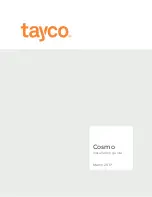
26
During the last third of the process time the polymer is reduced to carbon which either burns
away or remains loosely bound to the object being cleaned.
Any carbon or incombustible filler that remains on the processed item can be removed by a
secondary cleaning operation, either by brushing or some form of water wash.
It is important to ensure that the items being processed do not exceed the maximum loading
capacity (see Technical Specification) and that they are loaded into the fluidised bath in such a
way that the fluidisation is not impended.
THE PROCESS RELIES UPON GOOD FLUIDISATION TO ENSURE GOOD HEAT
TRANSFER; OVERLOADING OR INCORRECT LOADING OF THE BATH WILL RESULT IN
EXTENDED CYCLE TIMES GIVING INFERIOR RESULTS. LOCAL OVERHEATING MAY ALSO
OCCUR, GIVING RISE TO PREMATURE HEATER FAILURE AND POSSIBLE DISTORTION OF
THE INNER CONTAINER.
The aluminium oxide fluidising medium does not degrade but will need to be replenished due to
loss from spillage or entrainment in the exhaust (from where it may be recovered by a cyclone
trap).
All articles should be completely cleaned and removed from the bed before shut down. Corrosion
of processed parts could be seriously increased if they are left immersed overnight. Furthermore,
residual polymer, instead of being burned off in a fluidised state, could percolate down through a
static bed and settle on the porous plate to cause a blockage and result in poor fluidisation.
When parts are removed from the bed they should be allowed to cool in air and, whilst still warm,
treated to prevent rusting.
It should be noted that some plastics and, in particular, paints contain fillers. These fillers are
usually inorganic materials and will not therefore burn when put into a fluidised bath, with the
result that the material falls away from the article being cleaned and is retained in the bath, either
on the surface or at the base of the bath, depending upon the density of the material involved. If
this happens it is recommended that the bath be checked and cleaned at least once a week or
more frequently if the bath is used continuously.
The following table details recommended operating temperatures for particular polymers. The
temperatures quoted should be used as an initial guide.
The ideal operating temperature will vary depending on the size of the components being cleaned
and the amount of material being removed. In general temperatures below
400ºC should be avoided to obviate the danger of the polymer melting and sinking to the bottom
of the bath where it may block the porous plate. With some large objects it may be desirable to
pre-heat the bath to well above the operating temperature so that the polymer temperature rapidly
moves through the melting phase to the burning condition.
Excessive operating temperatures should be avoided as they increase the fume concentration
above the bath and may result in the formation of condensed fumes within the extraction system.
Material
Burn-off temperature ºC
Nylon
450
Paint
475-575
Polythene
450-500
Polypropylene
425-500
PTFE
500
PVC
450-500
Silicone rubber
550
Ethylene methacytic
450-480
Polyurethane
440-450
Summary of Contents for IFB-201
Page 1: ...IFB 201 OPERATOR S MANUAL...
Page 3: ...3 Spare Parts 31 Accessories 31 Circuit Diagrams 32...
Page 31: ...32 Circuit Diagrams...
Page 32: ...33...
Page 33: ...34...










































